
The Waterdrop G3 is a tankless RO system that’s installed under a kitchen sink. In our testing, the G3 P800 did an excellent job at removing lead, fluoride, arsenic, and more. But there’s no built-in remineralization filter and the unit’s tankless design has limitations.
What We Like
What We Don’t Like
| Price | $539 – $999 |
| Contaminants Removed | 1,000+ |
| Certifications | NSF/ANSI 58, 372 |
| Process | RO |
| Filtration Capacity | 550/ 1100/ 2900 gallons |
| Annual Cost | ~$145 |
| Warranty | 1 year |
There are two unit configurations in the G3 range:
- The G3 P600, with a 600 gallon-per-day (GPD) flow rate
- The G3 P800, with an 800 GPD flow rate
These systems use the same filter stages and the only difference is their water production rate: the G3 P800 is the faster model. We’ll be discussing both of these systems in this review, but with a main focus on the G3 P800, since this was the system that we installed and tested ourselves.
Related: Read our Waterdrop X Series review
Table of Contents
📊 Scoring Data
To obtain the scoring data for the water filters we review, we conduct our own testing at home. For some of our testing categories, we also obtain data from the product information and third-party testing available online. We use 6 main testing categories to rank a water filtration system, and we’ve shared the data behind the scores we assigned for the Waterdrop G3 P800 below.
| Criteria | Results |
|---|---|
| Health Related Contaminants | 9.50 |
| Aesthetic Related Contaminants | 3.50 |
| Performance Certification | Certified for 100% of reduction claims |
| Filtration Rate | 600 or 800 GPD |
| Component Quality | Outstanding |
| Component Certification | Certified |
| Setup | Weak |
| Servicing Requirements | Exceptional |
| Costs | $0.11/ gallon (w/o remineralization), $0.13/ gallon (w/ remineralization) |
| Company | Good |
🎬 Video Review
🚰 Contaminant Reduction
Score: 9.28We tested our drinking water for contaminants before and after filtering it through the Waterdrop G3 P800, which we combined with our research into the filter’s performance certifications to attain an overall score for contaminant reduction.
Our Performance Testing
Score: 9.20
We wanted to test the Waterdrop G3 P800 in our own home to see what it could remove from our drinking water supply.
Reverse osmosis systems purify water, removing more contaminants than a standard filter, thanks to their semi-permeable membranes. So, going into testing for the G3 P800, we expected to see a significant reduction of the contaminants detected in our feed water.
We tested our water with Tap Score and mailed our samples to the lab for professional testing. The company has a strict sample-taking protocol, which we followed closely to ensure that our results were accurate.

Our interactive report was available to view on the SimpleLab platform within a week. The report told us a few things:
- The quality of our water overall, with an assigned Tap Score from 1-99
- The contaminants detected in our water samples
- Whether these contaminants were linked to health, aesthetic, or plumbing effects
In the table below, we’ve shared the contaminants detected in our feed water and what percentage of these were removed by the Waterdrop G3 P800.
| Contaminant | Measurement | Pre-Install | Post-Install | % Change |
|---|---|---|---|---|
| Total Dissolved Solids | PPM | 84 | 15 | -82.14% |
| Arsenic | PPM | 0.0029 | 0 | -100.00% |
| Barium | PPM | 0.0283 | 0.0033 | -88.34% |
| Calcium | PPM | 20.2 | 2.6 | -87.13% |
| Chloride | PPM | 2.2 | 0 | -100.00% |
| Copper | PPM | 0.203 | 0 | -100.00% |
| Fluoride | PPM | 0.3 | 0 | -100.00% |
| Lead | PPM | 0.0008 | 0 | -100.00% |
| Magnesium | PPM | 2.13 | 0.27 | -87.32% |
| Manganese | PPM | 0.0048 | 0 | -100.00% |
| Nitrate (as N) | PPM | 1.1 | 0.1 | -90.91% |
| Potassium | PPM | 2.12 | 0 | -100.00% |
| Selenium | PPM | 0.0015 | 0 | -100.00% |
| Sodium | PPM | 9.33 | 1.65 | -82.32% |
| Strontium | PPM | 0.199 | 0.025 | -87.44% |
| Sulfate | PPM | 7.8 | 0 | -100.00% |
Health-Related Contaminants
Score: 9.50
Our unfiltered water contained trace levels of 10 contaminants with possible health effects: arsenic, fluoride, lead, strontium, barium, nitrate, copper, manganese, selenium, and sodium. Of these contaminants, we were the most concerned about arsenic and lead, since these were present at levels that exceeded the HGL (0.00029 PPM and 0.0008 PPM respectively).
Some of the possible health effects associated with these contaminants include:
- Developmental outcomes
- Skeletal health issues
- Blood and nervous system effects
- Cardiovascular health problems
- Effects on kidney and liver health
- Immune effects
- Carcinogenic (cancer-causing) effects
- Effects on the eyes and vision
- Gastrointestinal issues
- Reproductive outcomes
- Respiratory problems
In our purified water sample, 6 out of these 10 contaminants weren’t detected at all, meaning that the Waterdrop G3 P800 had effectively eliminated 100% of them from our water.
Only strontium, barium, nitrate, and sodium remained in tiny trace amounts (0.025, 0.0033, 0.1, and 1.65 PPM respectively) – well within the HGL.
TDS, pH, Minerals, & Salts
One of the setbacks of any system that uses a reverse osmosis membrane is that it reduces the good stuff as well as the bad stuff. The G3 P800 was no exception in our testing, removing healthy minerals and affecting our water’s pH.
Our unfiltered feed water contained 84 PPM of total dissolved solids. TDS is a measure of all dissolved solids in the water, including healthy minerals and salts (our feed water contained 20.2 PPM of calcium and 2.13 of magnesium, for instance). Post-filtration, our water’s TDS had been reduced by 82%, down to 15 PPM. Our water’s calcium and magnesium minerals were both reduced by 87%.
Aesthetic Contaminants
Score: 3.50
Our unfiltered water contained around 0.4 PPM of chlorine. This is pretty normal for municipal drinking water in the U.S. – chlorine is the most commonly used chemical for disinfection of water supplies.
We tested our water’s chlorine content using a test strip, which gave us immediate results. We couldn’t get our water lab tested for chlorine because it’s very volatile and would dissipate before we could get the water to our lab.
Post-filtration, we tested our water again. Our results showed that there was 0 PPM of chlorine in our purified water, so the Waterdrop G3 P800 had removed it all.
We’d expected this outcome given that the G3 P800 uses both an activated carbon filter (AC filters are commonly employed for removing tastes and odors and are endorsed by the CDC for removing chlorine) and a reverse osmosis membrane (RO membranes reject contaminants down to 0.0001 microns).
The demineralization of our purified water was the reason why our score for aesthetic contaminants was so low. Because the G3 P800’s membrane reduced our water’s dissolved mineral concentrations, it also resulted in a decrease in pH.
Our initial water pH was 7.3, just higher than neutral. Post filtration, its pH reading dropped to 6.3. This might seem alarming, but it’s normal for an RO system. We tested the G3 P800 without a remineralization filter, and it’s likely that our water’s pH wouldn’t have dropped – and might have even increased – if we’d remineralized it post-RO treatment.
Performance Certifications
Score: 10.00
The Waterdrop G3 combines three filter cartridges: a carbon block and sediment pre-filter (CF), an activated carbon coconut filter (CB), and a semi-permeable RO membrane (RO). These have been IAPMO certified to NSF 42, for removing chlorine, and NSF 58 and NSF 53, for reducing TDS, fluoride, cadmium, hexavalent chromium, and selenium.
We always try to look for reverse osmosis systems with official certifications where we can because it’s reassuring to know that a filtration system has been tested and approved by an organization we can trust. We were happy with the G3’s certifications, although we would have liked to see it tested to remove more contaminants under NSF 58.
For this ranking category, we compared the contaminants removed from our own water supply with Waterdrop’s certification data.
The G3 P800 removed fluoride and chlorine from our water, and reduced our TDS by 82%, but the other contaminants addressed by the filter haven’t been listed in the certification data, so we were unable to draw comparisons across the board.
In the table below, we’ve compared our testing data with IAPMO certification data for the G3 P800.
| Contaminant | IAPMO Certification | WaterFilterGuru Testing Data |
|---|---|---|
| Cadmium | Yes | Not Detected |
| Chlorine | Yes | 100% |
| Fluoride | Yes | 100% |
| Hexavalent Chromium | Yes | Not Detected |
| Selenium | Yes | Not Detected |
| TDS | Yes | 82% |
🚦 Filtration Rate
Score: 10.00Filtration rate for RO systems is measured in GPD (gallons per day) rather than GPM (gallons per minute). This makes it slightly more difficult to imagine the speed of water flow, but tankless RO filters like the G3 P800 typically have a slower flow rate because they need to send water through multiple filtration stages on demand.
As a reminder, we got the Waterdrop G3 P800 under-sink reverse osmosis system, which has a water production rate of 800 gallons per day. The other option is the Waterdrop G3 P600, which has a slightly lower capacity of 600 gallons per day. The G3 P800 stood out to us in our research because its 800 GPD water production rate is the fastest we’ve ever seen.
Efficiency Ratio
We found that the Waterdrop G3 P800 excels in this performance category. We’ve tested dozens of under-sink tankless reverse osmosis systems, and this Waterdrop model has one of the best efficiency ratios we’ve seen for a system of its kind.
The unit has a 3:1 pure-to-wastewater ratio, meaning that only 1 gallon of water is lost for every 3 gallons purified. Wastewater production is an unavoidable side effect of the reverse osmosis process, but most RO systems we’ve tested (even the modern ones) waste at least 1 gallon of water per gallon purified.
We’ve only tested a few countertop RO systems that have 4:1 efficiency ratios, but none that offer on-demand under-sink filtration like the G3.
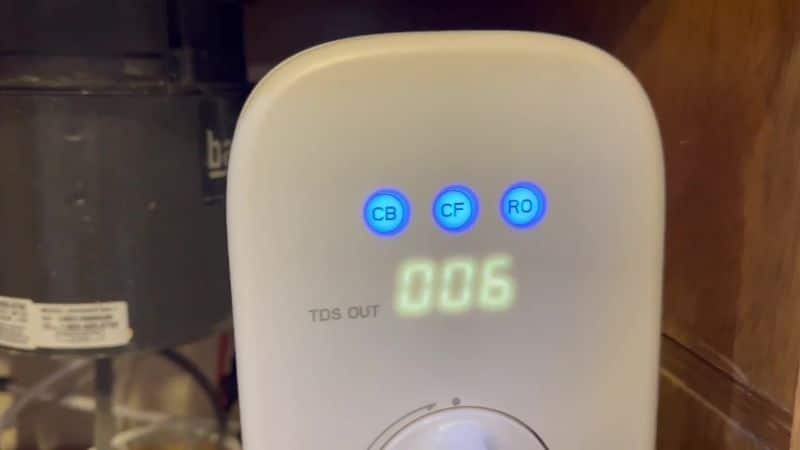
📐 Design
Score: 9.70In the design category, we ranked the Waterdrop G3 P800 based on its component quality and whether it had any certifications for its design materials.
Out of the box, our unit came with:
- The system housing and three initial filters
- A smart RO faucet
- A UV sterilizer
- A feed water adapter
- Three sets of flexible tubing
- A power adapter
- Drain saddle
- Five lock clips
- Teflon tape
As far as design is concerned, we were pleased with the features of this under-sink RO system.
Waterdrop is known for its smart systems, and the G3 P800 has a few useful features that made it easier for us to use the unit as intended. There are TDS meters on the smart faucet and the unit body, which we could use to check on the performance of the filters, and a filter life tracker, so we didn’t have to make our own calendar reminders for filter changes.
Another unique perk of the unit is that it comes with a UV purifier (which boasts a 99.9% sterilization rate), so we had the reassurance of protection against pathogens. The only thing we felt it was missing was a built-in remineralization filter – we could buy one from Waterdrop, but it needs to be installed separately and costs an extra $30.
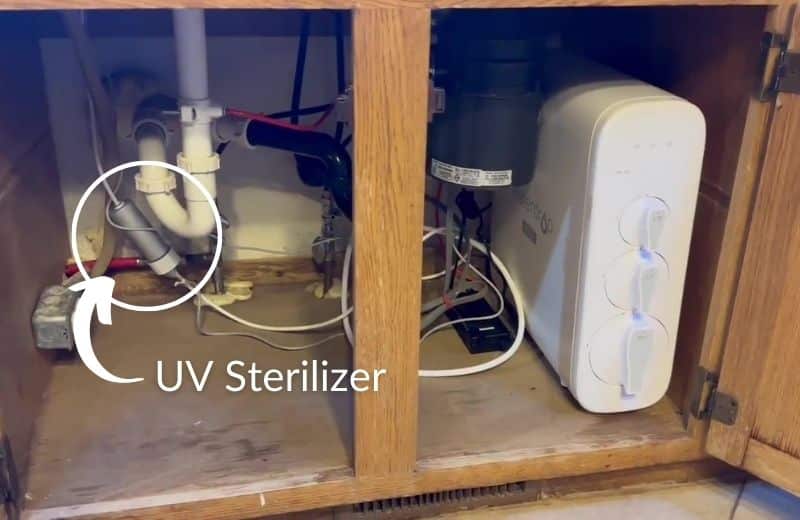
Design Setbacks
The G3 P800 is a tankless reverse osmosis system, which means it’s space-saving, can fit in smaller under-sink spaces with limited room, and doesn’t use a bulky water tank.
But we did find that this was a bit of a design setback when it came to accessing purified water. While tank-based RO systems store water in a pressurized tank and deliver it to your faucet instantly when you turn it on, tankless systems have to purify the water you need before it can be delivered to you. So our waiting time for filtered water was longer with the G3 P800 than it would be with a tank-based unit.
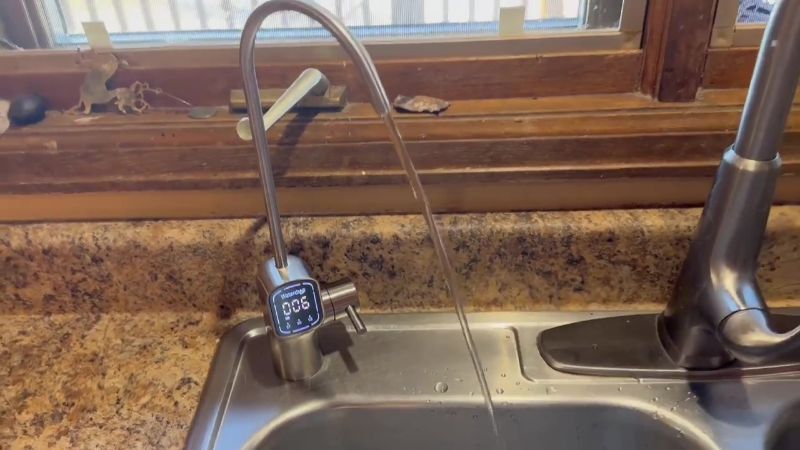
We love the G3’s value & performance – get $199 off & experience it yourself!👉 Click here for code
Component Quality
Score: 9.50
The G3 P800 is a plastic-based model. We reached out to Waterdrop to learn more about the types of plastics that are used in the system design, and we were told that the plastic components that the water comes into contact with are made from polypropylene (PP) and polypropylene (PE). These plastics are commonly used in making consumer goods because they’re rigid and relatively cheap, as well as being considered “relatively stable” and safer for food and drink.
That said, as with most plastics we’ve come across, there’s still concern about leaching additives (although heat, duration, and acidity increase leaching, and none of these are likely in a reverse osmosis system).
The unit comes with a lead-free brushed nickel faucet. The idea of having a dedicated faucet is that you can ensure no materials will leach into the water after it has been purified. Plus, you need to retain your own existing kitchen faucet for hot water (the RO system is for cold water only).
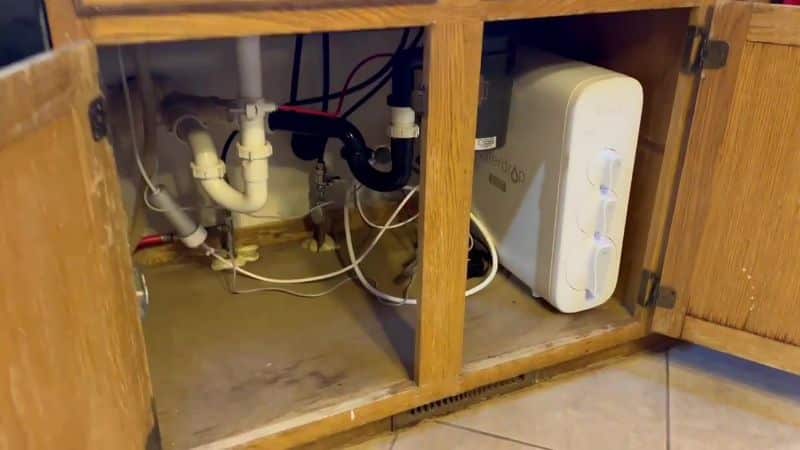
Certification
Score: 10.00
The Waterdrop G3 P800 ticked our boxes for materials safety certifications. Materials safety certifications were an included component of the unit’s NSF performance certifications. It also has an IAPMO certification to NSF Standard 372 for a lead-free design.
Filter Materials
There are three filters used in the Waterdrop G3 P800. The first is a carbon block and sediment pre-filter, followed by an activated carbon coconut filter, and then a semi-permeable RO membrane.
Waterdrop doesn’t go into great detail about the exact materials used to make these filters, but our research tells us that activated carbon filters are generally made from natural materials, and RO membranes are thin film composite membranes made from cellulose acetates, polyamides, polyimides, and poly-sulfones.
We couldn’t find any evidence to suggest that these materials might be unsafe for water filtration, and there have been dozens of studies that support the safe and effective use of RO membranes and activated carbon filters for drinking water treatment.
The filter housings themselves are made of plastic, as is typical for most water filters.
⚙️ Setup
Score: 7.00We evaluated the complexity of installing the G3 P800, and how long the process took us.
We found that installing the Waterdrop G3 P800 was much easier than installing a traditional under-sink RO system, and the unit took up less space (it measures just 5.67 inches across).
In all, installing the system took us around 1 hour 30 minutes from start to finish.
We installed it at our cold water pipe using the provided flexible tubing. Everything we needed for installing and setting up the system was included in our box, and the user manual has a detailed 8-step installation process, with diagrams included, which we found easy enough to follow.
There’s a bit of extra work required to drill a hole in your countertop for the RO faucet, which you’ll have to do if you don’t already have a hole (such as for a soap dispenser). We don’t recommend replacing your existing faucet with the RO faucet because the system can only be used with cold water, so you still need an additional faucet for hot water.
We also had to connect the drain pipe to our drainage system, since we needed to be able to direct the wastewater somewhere.
Do we think the install is possible if you’re not confident with DIY? Yes, but make sure to follow the instructions in the user manual carefully.
🔧 Maintenance
Score: 10.00When rating the Waterdrop G3 P800 in the Maintenance category, we evaluated its servicing requirements and the cost per gallon of the filters.
Servicing Requirements
Score: 10.00
Our only regular maintenance task for the G3 P800 was to change the filters according to the filter replacement schedule. Note: the first set of filters was included with our initial purchase.
Here’s the key maintenance information to be aware of:
- The CF filter needs changing every 6 months
- The CB filter lasts for 8-12 months
- The RO membrane lasts for two years
- The UV lamp doesn’t need changing at all – it lasts up to 50 years with little or no maintenance required
We didn’t have to remember to replace our filters because the G3 P800 has a built-in filter change reminder. This is just an indication based on gallon usage or time, whichever comes first. So if you use a lot of water, the filter will need replacing more frequently due to your faster gallon usage.
Changing the filters was quick and easy, and we didn’t have to shut off our water or power supply. We just had to twist out the old filter, insert the new filter in its place, and reset the filter life timer.
Our only annoyance was having to flush the filters after changing them – the CF filter flushes automatically, but we had to turn on the RO faucet to flush the CB filter for 15 minutes, which was time-consuming and felt wasteful. The same must be done when replacing the RO filter, except you have to flush it with water for 30 minutes (we haven’t had to replace ours yet).
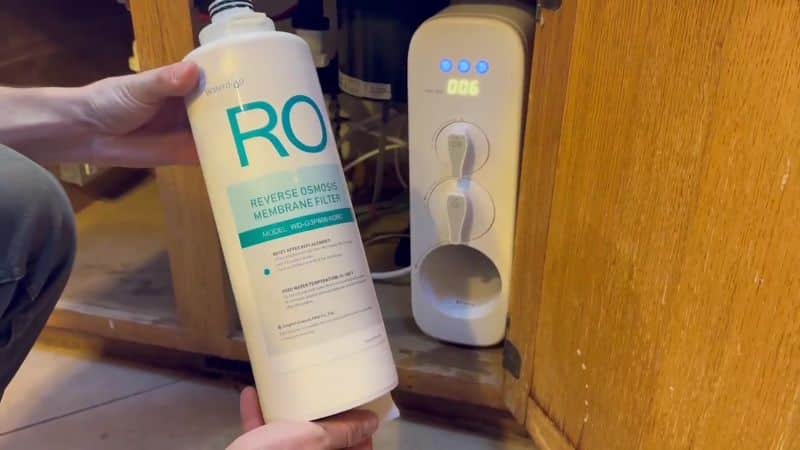
Costs
Score: 10.00
To determine the G3 P800’s long-term value for money, we calculated the cost per gallon of each of the filters in the unit, then combined them to get a total figure.
The system’s cost per gallon without the remineralization filter is $0.11/ gallon. With the remineralization filter, its cost per gallon is $0.13/ gallon.
That means the G3 P800 has one of the lowest costs per gallon of all the filtration systems we’ve tested, even with multiple filters to replace.
🏢 Company
Score: 8.80Lastly, we graded the warranty, shipping, and returns offered by Waterdrop for the G3 P800.
Warranty
Score: 8.50
The Waterdrop G3 P800 is backed by a 1-year warranty, which covers any defects that occur during the warranty period (due to a quality issue and not misuse). The warranty entitles customers to free returns, repair services, or replacements, depending on the issue reported.
You can view the warranty terms on page 18 of the user manual.
Shipping
Score: 9.5
Waterdrop offers free Economy Shipping for all its products, and provides delivery to most US states. Waterdrop currently doesn’t ship to Alaska, American Samoa, Hawaii, Guam, Marshall Islands, Micronesia, Northern Mariana Islands, Palau, Puerto Rico, or the U.S. Virgin Islands.
For faster delivery, you can upgrade to Standard Shipping (at no extra cost if your order is over $200) or Express Shipping (at a cost of $12.99).
View Waterdrop’s shipping policy here.
Returns
Score: 8.00
The G3 P800 is backed by Waterdrop’s 30-day return policy. The product should be disassembled and returned in its original packaging, and you’ll need to cover the return shipping fee.
Waterdrop also allows for returns beyond the 30-day returns window, but there’s a 10% restocking fee as well as the return shipping fee.
Here’s Waterdrop’s returns policy for more information.
We love the G3’s value & performance – get $199 off & experience it yourself!👉 Click here for code
Found this review helpful?
Comment below or share this article!


Hi Brian,
Thanks a lot for the review. Any antimony found in the G3 Models (like the X Models)?
Thanks
Nope, you can see all the data from our testing in the Contaminant Reduction section above
Super confused about the certifications of this RO system. Your review states “We were happy with the G3’s certifications” and that it’s NSF 58 certified for TDS, fluoride, cadmium, hexavalent chromium, and selenium. That’s 5 contaminants. The claims posted throughout the Waterdrop website state “G3 RO system passed 400+ chemical lab tests” and their CSR email to me (which I’m pretty sure was just an AI generated auto-response) stated “The G3p800 RO system is certified to effectively remove 1000+ contaminants, including fluoride and heavy metals. The system has been tested and proven to reduce a wide range of contaminants, and the reduction data for fluoride and heavy metals is available in the Performance Data Sheet.” The Customer Service sent no further response after I asked them to supply said PDS. Their site links to a couple performance related documents, including the NSF listing (only TDS and Chromium 6 in the NSF certification), also this PDS (https://cdn.shopify.com/s/files/1/0078/6156/7570/files/WD-G3P600_Specification_Sheet_for_Reducing_Harmful_Substances.pdf?v=1672391467 (lists no PFAS, Fluoride, and no heavy metals, no date or lab which performed the tests is listed either). Then there’s this IAMPO listing of the 5 contaminants you mentioned https://pld.iapmo.org/file_info.asp?file_no=0013976. So I’m trying to reconcile you recommending this system and saying that you’re happy with their certifications with the complete absence of hard data on such critical contaminants as fluoride, heavy metals, and PFAS. Would appreciate your further thoughts on how to judge this system’s removal capability. Many thanks for your thorough research and reviews!
Hi Ana, thanks for your comment. What you see here with this Waterdrop system being certified for the reduction of a handful of contaminants is common practice in the industry. In fact, very few brands achieve certification for every single contaminant they claim to reduce (unfortunately). This is why, when reviewing products, we consider the contaminants a product claims to reduce and compare that to the actual certifications it holds. Products that hold certifications are prioritized over those that don’t. In our own independent testing, the G3 system completely eliminated arsenic, lead, strontium and fluoride, however it did not detect PFAs.
“however it did not detect PFAs.” – do you mean the water you tested had no PFAs, or the filter did not work for them?
Do you know if it removes HAA5 or HAA9?
Also do you believe your independent test results would be the same for the G3600? Does the G3800 have more layers carbon than the 600? I don’t need 800 capacity but am wondering why it’s almost twice as expensive as the 600 if the only difference is the UV filter and speed?
Thank you so much for sharing your detailed research!
PFAs were not included in the test we used, so I don’t have data on performance even if they were present. The system should be able to target PFAs with both the carbon filter stage and RO stage.
Yes, it should address haloacetic acids (HAAs).
It’s hard to speculate on the performance of the 600 GPD system – I’d really prefer to have hard data to discuss performance
I am currently looking at this system, just wondered if you ever hooked up the Remineralization filter and had that water tested to see what it actually added back. Are there other remineralization filters that are compatible with this system that you have tested or recommend? Thanks for the thorough review.
We have not yet tested the remineralization filter, however this is on the to-do list!
I’m in the same boat as Michael (well with water softener). However, I have had a water analysis done which showed low levels of arsenic (which is the motivation for possibly getting a system). How do I find out what well water contaminants the GP3800 can’t tolerate?
Hey Dave, great question. Common well water contaminants and issues that would damage the system are things like bacterial contamination, hydrogen sulfide, tannins, pH imbalance, excessive hardness, iron, manganese, turbidity, TDS, etc.
In addition to the low levels of arsenic, what else does the lab report indicate? How comprehensive was the testing that was done?
Thank you Brian,
We’ve been testing the well water every other year…this is the year for our next test. The last test indicated that our old water softener was making the water “…too soft.” Hence the new digital, based on use, softener.
I will check out Tap Score above…I will check back here.
Thank you very much for your help!
Michael
Happy to help Michael!
My wife and I have been reviewing a number of RO systems…and she likes the G3P800. We can re-mineralize manually by adding Celtic or Himalayan sea salt. Our challenge is that Waterdrop says that their systems cannot be used with well water…do you know why? We have a well.
Thank you,
Michael
It’s because many common well water contaminants will damage the RO system if not properly treated first. Do you already have a well water treatment system in place?
…not sure what that entails…we have a brand new water softener…but I imagine that just over-loads an RO system. What type of well water treatment system should we look at?
Thank you Brian, my email is, [email protected] if that is easier. My cell is 845-702-1004…we live about 70 miles north of NYC
Michael
The first step is to get your water tested. As a well owner, it’s best practice to be testing on a yearly basis (at a minimum). The testing data will indicate what (if any) types of treatment systems you need.
It sounds like you’ve installed a water softener, which will reduce hardness and scale issues, and may address other common well water contaminants like iron as well. This may or may not be sufficient. Again, you won’t know until you test.
Check out Tap Score for water testing, hands down the best service I’ve come accross